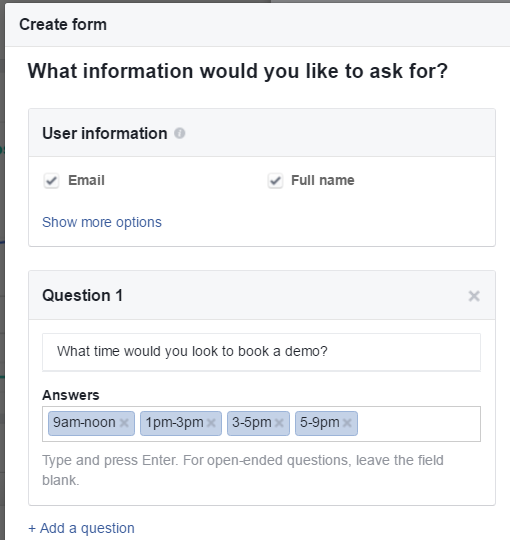Lead Ads are a useful yet underused ad objective by ecommerce businesses and most online businesses in general.
They can do a whole lot more than just increase your email list, which I’ll be discussing in today’s article.
Here are six ways to use Lead Ads to grow your business.
1. Test a new product or service idea
As a business owner or online marketer you’ll always be coming up with ideas or features that you think may work, but you aren’t totally sure. Lead Ads are a great way to test your ideas with minimal spend.
To give you an example, a friend of mine was thinking about starting a wine subscription business in his local city. Instead of building a fancy website and buying stock, he simply ran a Lead Ad to collect email addresses to query the demand for his service.
He collected 41 leads and four people were ready to sign up on the spot after his first email. With this information he decided to take things to the next step and build his website.

Lead Ads are useful to test product or service ideas.
2. Dispense discount codes
A lot of ecommerce websites will list discount codes directly on their website, which is a fine strategy, but it does come with a few drawbacks. With the average online consumer visiting a minimum of five stores before coming to their decision, there’s a good chance they won’t pick your business and will forgot about you during their next search.
A great way to get these prospects to revisit your store hoping they convert second time round is to serve them a discount code through a Lead Ad. After obtaining their email address you can send them weekly emails to keep your brand fresh in their mind.
3. Improve your lookalike audiences
Lookalike audiences is a powerful tool to target people in the upper level of your funnel, but for businesses with old customer lists or B2B-heavy databases, you’ll often match less than 50% of your audience from your database.
If this is a problem you face, to further optimize your lookalike audiences, go ahead and capture leads from people who spent the most time on your site or viewing specific product pages. Combining this tip with a discount code (#2) is perfect to lower your ad costs due to having sharper lookalike audiences.
If you want to directly connect your Lead Ads leads with your CRM/ESP and auto-sync email list-based custom audiences with a list in your ESP, there are great tools like LeadsBridge that can save you from having to constantly export and upload CSV files.
4. Pre-sale tool
When selling high-ticket items, people need more time to research and think. Consumers will happily buy a $15 t-shirt they saw on Facebook, but will consult with their friends, family, and even their bank when they decide to buy a $40,000 car.
Time is needed to convert high-ticket items, and you can use Lead Ads in the top part of your sales funnel. Once they opt-in to receive a free demo, report, consultation, or product information pack, you can then start adding layers through email marketing or telemarketing to push them through.
The objective here is to nurture the prospect and get them in a state to buy when you launch your high-ticket item. This all starts with grabbing their email address and maybe even their home address or telephone number, which is simple to do using a lead form.
5. Sell the old fashioned way
Omni-channel shopping is the future. Some consumers want the option to view your products online and buy in-store, or to view and test a product in-store but have it delivered to their door.
Do you sell SaaS or have a brick and mortar store to supplement your ecommerce website?
Give consumers the option to book a demo though Lead Ads by asking them what time they would like to receive a call or would like to pop in-store to demo your product.

Lead Ads do more than collecting emails; you can also ask the user questions.
6. Run a contest
Before the introduction of Lead Ads, running a contest on Facebook was incredibly difficult. You either had to pay to use a third-party plugin or you had to create a fancy landing page that was mobile-friendly and didn’t contain too much rich media.
With Lead Ads, you can ask questions directly through the form and the barrier of entry is lowered because users don’t have to leave Facebook or even type out their personal details.
Note: When running a contest, you will need to add an extra section to your privacy policy stating how the contest works. You will also need to check local law in your state as you may require a license if your contest is a lottery.
Summary
Like I said earlier, Lead Ads can do more than just grow your email list. You can create stronger lookalike audiences, get prospects coming back to your website, use it as a marketing tool to pre-sell a new product, and even get prospects to arrange a free demo of your product or service.
How are you using Lead Ads?